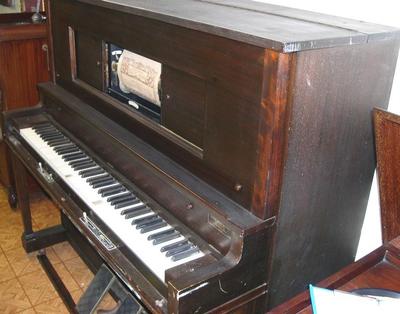Pianola [Aeolian]
Maker and role
The Aeolian Company, Manufacturer
Chas. Begg and Company Limited, Distributor
Production date
Circa 1920s
See full details
Object detail
Accession number
2006.340
Production period
Description
This instrument is best described as a self-playing piano. The notes to be played are represented by tiny perforations on interchangeable rolls of paper, while the player mechanism is powered entirely by suction, generated by the operation of two foot pedals. The operator, or 'pianolist', achieves dynamic shading of the music by varying the degree of pressure applied to the foot pedals. In addition, a set of hand-operated levers mounted just below the front of the keyboard provide accentuation, tempo control, activation of the sustain and soft pedals and selection of play and rewind modes. In the hands of an accomplished operator, a convincingly lifelike musical performance is achievable. Pianola is made of wood.
Brief History
A player piano, often referred to as a pianola, plays music mechanically by means of a perforated paper roll on which the notes are recorded. The term 'Pianola' was originally a trademark, first used by the Aeolian Company who made this example, but it became a generic reference to the self-playing piano.
The Aeolian Company was founded by New York City piano maker William B. Tremaine as the Aeolian Organ & Music Co. (1887) to make automatic organs and then, after 1895, as the Aeolian Company, automatic pianos as well. The pianola, a pneumatic player piano was invented in 1895 by Edwin S. Votey. In 1897, Votey joined Aeolian and in 1900 the firm obtained the patent for such instruments. In 1903, Tremaine absorbed a number of companies making self-playing instruments into the Aeolian, Weber Piano & Pianola Co. The company became the world's leading manufacturer of such roll-operated instruments.
The player piano enjoyed its peak of popularity between 1900 and 1930, after which radios and phonographs, significantly cheaper and more versatile, became the main source of home entertainment.
The Aeolian Company was founded by New York City piano maker William B. Tremaine as the Aeolian Organ & Music Co. (1887) to make automatic organs and then, after 1895, as the Aeolian Company, automatic pianos as well. The pianola, a pneumatic player piano was invented in 1895 by Edwin S. Votey. In 1897, Votey joined Aeolian and in 1900 the firm obtained the patent for such instruments. In 1903, Tremaine absorbed a number of companies making self-playing instruments into the Aeolian, Weber Piano & Pianola Co. The company became the world's leading manufacturer of such roll-operated instruments.
The player piano enjoyed its peak of popularity between 1900 and 1930, after which radios and phonographs, significantly cheaper and more versatile, became the main source of home entertainment.
Marks
Aeolian Pianola Printed
Collection
Credit Line
The Aeolian Company et al. Circa 1920s. Pianola [Aeolian], 2006.340. The Museum of Transport and Technology (MOTAT).


Public comments
Be the first to comment on this object record.